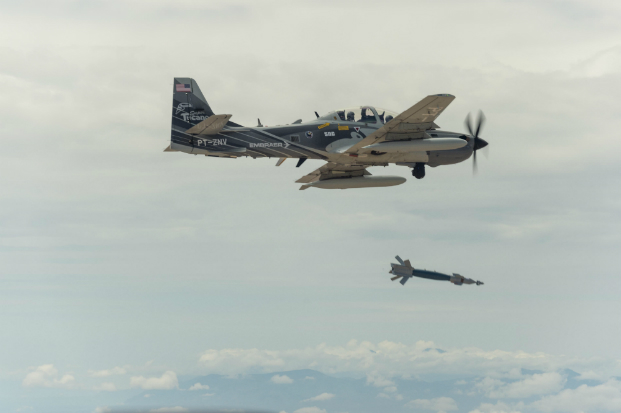
An Embraer Super Tucano A-29 experimental aircraft flies over White Sands Missile Range, N.M. USAF photo by Ethan D. Wagner.
A fatal A-29 crash last summer, which led the Air Force to prematurely end flights during the second phase of its light-attack experiment, was caused by the pilot’s “overcontrol” after dropping a bomb, according to an accident investigation report published Feb. 22.
The accident instantly killed Navy Lt. Christopher Short, who was flying the Sierra Nevada-Embraer Super Tucano at the Red Rio Bombing Range in New Mexico shortly before noon on June 22, 2018.
“By turning too sharply at low airspeed after release of a practice bomb, the aircraft entered an uncontrolled spiral dive,” the accident report said. “Additionally, the specific cause of the mishap pilot’s death was delayed ejection. After unsuccessful attempts to recover the aircraft, ejection was initiated below the recommended minimum altitude for uncontrolled flight, preventing the parachute from fully inflating.”
The training sortie was uneventful until the two-man crew fired a BGU-12 from the A-29’s left side, then tried to bank 180 degrees to the right. Attempting that sharp turn without the weapon caused the aircraft to roll and spin out of control, investigators found. The crew tried four times to right the plane before ejecting.
“Fixation, critical information not communicated between the [mishap crew] during the recovery, and operation of the ejection seat selector as directed in single mode substantially contributed to the fatality,” the report said. An Air Force weapon systems officer onboard ejected with minor injuries.
The light-attack experiment vetted turboprop platforms that could offer a more affordable option for counterterrorism missions in the Middle East, as the Air Force looks to prepare its advanced fighter jets for a potential conflict with Russia and China. SNC and Embraer pitted their A-29 against Textron’s AT-6B in the second round of experimentation, but the service recently said it plans to broaden the initiative to include other types of aircraft.